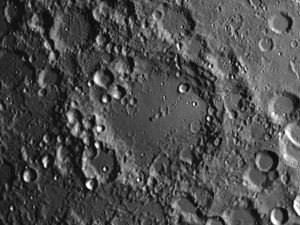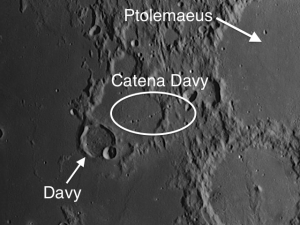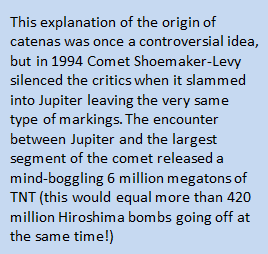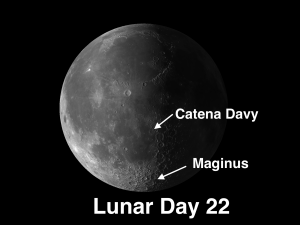The week of November 21-27 takes us from the end of Lunar Day 22 (the beginning of last quarter) to Day 28. This week we will highlight the crater Maginus and Catena Davy, visible early Tuesday morning around 2:30 AM local time.
 Maginus: [SW/Q9] Located at the eastern tip of the diamond formation that includes Tycho, Longomontanus, and Clavius. Maginus has sometimes been referred to as a “little Clavius” (the large crater just to the S.E. of Maginus that we covered in the June 27th blog). Can you see the similarities?
Maginus: [SW/Q9] Located at the eastern tip of the diamond formation that includes Tycho, Longomontanus, and Clavius. Maginus has sometimes been referred to as a “little Clavius” (the large crater just to the S.E. of Maginus that we covered in the June 27th blog). Can you see the similarities?
There is a wealth of smaller detail within Maginus that is revealed by larger telescopes. How much are you able to see?

 Catena Davy: [SW/L9] This fascinating crater chain was made when a comet or asteroid was torn into pieces by the gravitational pull of the Earth or the Moon. The alignment of smaller pieces flying through space then slammed into the Moon in machine-gun fashion, leaving a trail of small craters in a straight line. The largest of these craterlets is only a few miles wide and requires high magnification and good seeing.
Catena Davy: [SW/L9] This fascinating crater chain was made when a comet or asteroid was torn into pieces by the gravitational pull of the Earth or the Moon. The alignment of smaller pieces flying through space then slammed into the Moon in machine-gun fashion, leaving a trail of small craters in a straight line. The largest of these craterlets is only a few miles wide and requires high magnification and good seeing.
OF ADDITIONAL INTEREST THE WEEK OF NOVEMBER 21-27:
Last week we highlighted the “Extreme Supermoon” that was visible on Sunday and Monday. The APOD site (Astronomy Picture of the Day) featured a remarkable photo of the Supermoon that was taken just as the International Space Station was going across its face. To see this highly unusual photo, go to … Astronomy Picture of the Day
======================
It is highly recommended that you get a copy of Sky and Telescope’s Field Map of the Moon, the very finest Moon map available for use at the telescope. It is available for $10.95 at www.skyandtelescope.com and on Amazon. All features mentioned in this blog will be keyed to the grid on the Field Map and will look like this: Plato: [NW/D9]
Credits:
Courtesy of Gray Photography of Corpus Christi, Texas
Lunar photos: NASA / USGS / BMDO / LROC / ASU / DLR / LOLA / Moon Globe. Used by permission
- Hippalus Rilles on the Moon - April 15, 2024
- Moon Crater Janssen: How New Moon Craters are Superimposed on Top of Older Craters - April 8, 2024
- Crater Longomontanus on the Moon - April 1, 2024
